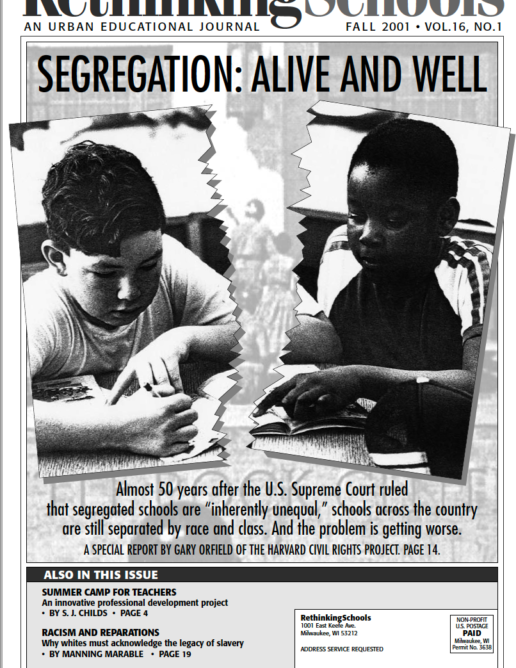The Three R’s
Race, Reparations, and Responsibility
The beginning of the 2001-2002 school year coincided with the World Conference Against Racism in Durban, South Africa. Despite the refusal of the United States to send a high-level delegation and its subsequent walkout, and despite the U.S. media’s lukewarm coverage of this historic event, the conference was an invaluable acknowledgment of what remains a defining issue not only of the 20th Century but the beginning years of the 21st Century — the color line.
As W.E.B. DuBois noted in his seminal 1903 work The Souls of Black Folk, “The problem of the 20th Century is the problem of the color line, the relation of the darker to the lighter races of men in Asia and Africa, in America and the islands of the sea.”
The issues raised at Durban have crucial educational dimensions. One of the important stumbling blocks in the extraordinary meetings was the refusal of the U.S. and European Union governments to acknowledge that slavery and the slave trade was a “crime against humanity.” They worried that if slavery was indeed a crime, committed in part by governments and corporations still around today, these modern-day entities might be held accountable for their past actions, and forced in some manner to pay compensation — reparations. This would be especially true, of course, because it wouldn’t be difficult to prove that these institutions profited from slavery.
But as Manning Marable points out in his article on page 19: “Demanding reparations is not just about compensation for slavery and segregation. It is, more important, an educational campaign to highlight the contemporary reality of ‘racial deficits’ of all kinds, the unequal conditions that impact Blacks regardless of class.”
THE ROLE OF TEACHERS
This is where we educators come in. As is so often the case, social justice movements offer us “teachable moments.” The tumultuous meetings in Durban and the gathering movement for reparations provide just such opportunities to explore the historical impact of racism in our lives.
This can take many forms, and requires analyzing both educational policy and educational practice in the classroom. On a policy level, Gary Orfield’s report on the resegregation of U.S. schools (page 14) offers a sobering look at the modern-day reality of “separate and unequal.” In the classroom, there are various ways to help students understand the still-entrenched reality of racism. Wayne Au, in his article on using the Black Panther Party’s Ten Point Program (page 21) asks students to develop contemporary agendas for action. First grade teacher Stephanie Walters (page 10) draws on young people’s experiences in the Civil Rights Movement to urge her students to reflect on fairness and activism.
Another educational manifestation of the reparations/rethinking slavery movement has played out in a remarkable drama at Yale University in New Haven, CT. There, on Yale’s 300th anniversary, three graduate students cracked through the Ivy League complacency to underscore that slavery was not just a Southern institution, but was integral to Northern prosperity. The students discovered that eight of Yale’s 12 residential colleges are named after slave owners (including the notorious John C. Calhoun) or those who preached in favor of slavery; the college’s first endowed chair, the Livingstonian Professorship of Divinity, was named for its benefactor, Col. Philip Livingston of New York, one of the most prominent slave traders of the mid 18th century. In putting their own institution under the microscope, the graduate students showed how Yale’s current prosperity owes its existence, at least in part, to the enslavement of African Americans.
K-12 teachers might engage students in similar scholarship, exploring how life in our communities today has been built on foundations of racial exploitation and otherwise celebrates such exploitation.
When calling for reparations, delegates to the World Conference Against Racism linked slavery and colonialism, pointing out that Africa, in particular, was devastated by a system that distorted its development to serve European masters. For example, African railroads were built not to connect Africans with one another, but were constructed strictly from the interior to the sea — to drain the continent of its riches.
Thus it is an especially bitter irony that many African nations today are saddled with massive debts to banks in the very countries that built their own economies with wealth extracted from slave labor and colonialism. Today, throughout Africa, countries spend more simply paying the interest on their debts than they allocate to health, education, and other social services combined.
One possible reparation suggested in Durban is to cancel the debt owed by former colonies to banks and institutions in the so-called developed world. This demand links the Durban gathering to the growing movement against corporate globalization, a movement which also calls for debt cancellation, and for a more humane, ecological reorientation of the global economy.
One of the key aims of critical teaching is to search out connections between seemingly disparate phenomena. How does the slave trade connect to today’s inequalities — whether between nations or within the United States? The historic Durban conference and the growing movement for reparations provide educators with opportunities to explore such questions. Let’s use them.

